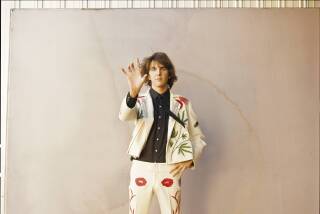Parsons Proves His Skills as Dancer and Top Choreographer
At 40, David Parsons is the master of nearly everything that can be learned about modern dance: its potential for stylistic variety, athletic excitement, sexy glamour and technological novelty, for instance.
However, up to now Parsons has always seemed to be consolidating or popularizing the innovations of others. And the only work of his that audiences always remember is “Caught,” the 1982 solo (music by Robert Fripp) in which intermittent strobe flashes and that perceptual characteristic known as persistence of vision make the dancer seem to hover magically in the air.
On Friday, Parsons himself performed “Caught” on a seven-part Parsons Dance Company program in Royce Hall at UCLA. And, as always, the simplicity, humor and wonder of the piece made it the evening’s highlight. Parsons also danced the role of odd man out in “Mood Swing” (1994), in which music by Morton Gould accompanied a manic-depressive seesaw: wildly giggly group dances versus slumpy and morose ones. The juxtaposition of extremes also dominated the restless octet “Closure” (1996), in which constant, dramatic shifts in Howell Binkley’s lighting and the score by Tony Powell signaled changes in the dancers’ vocabulary, level, kinetic scale and emotional temperature.
It’s easy to call these pieces glib because Parsons reveals no urgent purpose in them, no deep insight, no sense of how their elaborate technical playoffs might express something more than mere virtuosity. So, too, the intricate sexual tangles assigned the nine dancers of “Union” (1993, music by John Corigliano) and the formal gamesmanship of “Bachiana” (1993), which seems nothing other than a dissection of the great Baroque pieces that Parsons performed while a leading dancer in the Paul Taylor company.
Glib these pieces certainly are--but also remarkable for their inherent, often subtle musicality and unfailing technical sophistication. Indeed, it may be a minority opinion, but the program Friday supplied evidence that Parsons’ choreographic career up to now has been essentially a public workshop or apprenticeship in which he’s resolutely polished his skills to a level that is now quite beyond nearly every other choreographer in his generation.
More to Read
The biggest entertainment stories
Get our big stories about Hollywood, film, television, music, arts, culture and more right in your inbox as soon as they publish.
You may occasionally receive promotional content from the Los Angeles Times.









